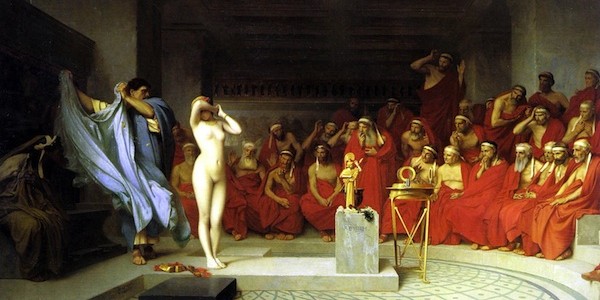Phryne (c.371BCE Р?) was an ancient Greek courtesan from 4the century BC. She was nicknamed ‘Phryne’ Рthe Greek word for toad Рdue to her yellow complexion. Despite this she was considered very beautiful; not only that she was very intelligent and witty. When the walls of the city of Thebes were destroyed she offered to pay for the rebuilding, on the condition that on the new walls was the sign ‘destroyed by Alexander, restored by Phryne the courtesan’. Unsurprisingly, her offer was not taken up.
One of the most famous incidents of Phryne’s life was her trial. It is not known for certain what she was on trial for, but most sources believe it was for impiety. Impiety is a ‘lack of piety or reverence’ and was a serious accusation in Ancient Greece, people believed that a lack of respect for the Gods could bring their wrath, as such atheists were persecuted in Athens at this time. One of the most of famous cases of this was Socrates, who was executed for impiety in 399BCE. Phryne was defended by the orator Hyperides, who was also her lover. We know that she was eventually acquitted but there are two different accounts of how this was achieved.
The first was recorded by Athenaeus. He claimed that when it seemed the trial was not going their way Hyperides removed Phryne’s robe to show the jury her breasts. Startled by her beauty, and not wishing bring on the wrath of Aphrodite they decided to acquit her. The second was recorded by Posidippus of Cassendreia, in which Phryne pleaded with each member of the jury, with tears in her eyes and so passionately, they felt pity for her and decided to acquit her.
She also provided inspiration to many artists, she is believed to have been the model for the statue of Cnidian Aphrodite by Proxiteles, who was also her lover. She is also believed to have been the inspiration behind the painting of Aphrodite by Apelles, when he saw he bathing in the sea at the festival of Poseidon.
Phryne is remembered today as one of the most famous and beautiful of the courtesans of Ancient Greece, she was very successful in captivating men, and a muse for many famous pieces of art work. She is strongly associated with the goddess Aphrodite, goddess of love and beauty.
-Danielle Triggs
Junior Girl
Girl Museum Inc.

